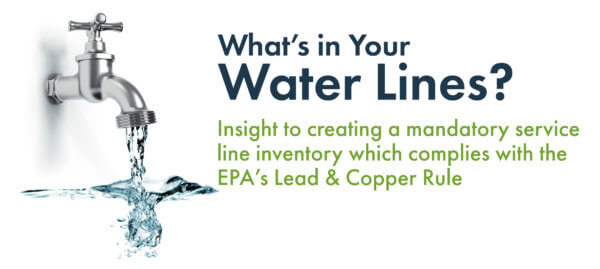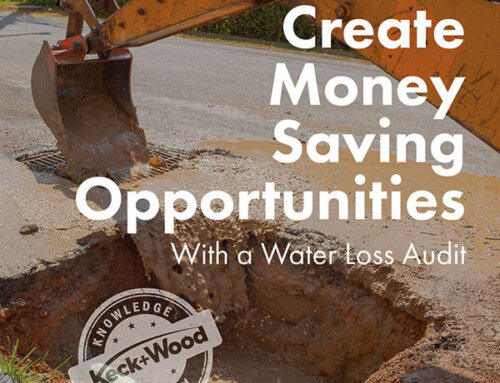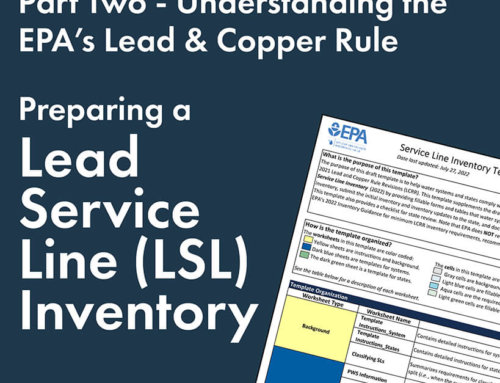
Recently, the EPA published significant revisions to the Lead and Copper Rule, which will affect water utilities and providers across the nation. The deadline for compliance will approach quickly for those who are not prepared. In Keck + Wood’s Information + Knowledge series, we can help answer the question of what community municipalities can do today to be ready for compliance tomorrow.
Lead & Copper Rule Background
Initially published in 1991 to address elevated harmful levels in drinking water, the Environmental Protection Agency, or EPA published revisions to their Lead and Copper Rule in December 2021. As consumers, we are excited about the prospect of clean, healthy water. As solution providers, we see the compliance deadline of October 16, 2024 as a wake-up call for water authorities to get started.
The question water providers need to ask: “Do We Have A Current Water Service Line Inventory?”
Know What’s in the Ground!
Compliance with providing the Service Line Inventory for the EPA will require significant effort from water providers to accurately identify the material of all service lines on both the utility and customer owned side. There are several methods to obtain this data, providing multiple pathways to compliance. In this article, we discuss a few key methods of material identification and some important things to consider while evaluating each method.
Material & Installation Records
Historically, utility providers kept records of water and service line installations. These records can be in the form of service tickets, permit records, or as built development plans. If historical records have been maintained, they can provide a straight-forward method of material identification. Any missing data can be supplemented with one or a combination of the inventory methods in this article.
Because this method relies heavily on historical records, the level of completeness will vary between utilities, potentially with periods of lost documentation. It is also important to keep in mind that these are generally the records of original installation, and could have been removed or replaced for various reasons. If the replacement of lines due to personnel or customers, additional verification of the material is recommended. While having the existing documentation is a good first-step approach, the data will still need to be compiled, reviewed and placed in a GIS or other cohesive database for review, additions & use.
Data Collection Through Utility Standards
Another method is reviewing the Utility’s historical written standards that dictated standard operating procedures, practices, details, building codes, etc. These reference points can demonstrate what pipe materials are presently in use as service lines. By utilizing historical standards to build a water service line inventory, water providers can identify what materials would have been accepted within a given time period when those standards were in effect. Coupling these with research on the material records, can serve as material verification or to fill in the missing gaps in the timeline.
Meter Box Evaluation
Exposed service line connections can be evaluated within residential meter boxes or commercial meter vaults. Through lead field test kits and magnet testing, lead or galvanized piping can be quickly identified or confirmed by field personnel.
Meter box evaluations can also be coupled with a customer education and outreach program to increase the data collected. In this program authorities can educate customers on the hazards of lead service lines, and how you as a utility are working to address them. If additional material identification data is sought, a non- intrusive method of service line material evaluation is to coordinate access to a basement or crawl space to observe the service line material at the point of entry. Because in this method of evaluation you have field personnel at each meter box, it can be helpful to include identification requirements into any existing or pending construction projects that may involve meters. By including these, some of the labor burden can be removed from the utility provider. Eligible projects include system wide AMI improvements and meter relocations. Streetscape projects may also include meter relocations and represent an excellent opportunity to capture information pertaining to the existing service line materials.
When in Doubt, Check it Out with Excavation!
Whether it’s through hand excavation or potholing utilizing a vac-truck, excavation will uncover a service line and allow for field materials testing to identify each service line. Whether this method is subcontracted or performed in-house by the utility provider, it is a best practice to associate each pothole or excavation with a field collected coordinate or other GIS identifier for future integration into a digital database.
Point of Use (POU) Water Testing
This method involves sampling different draws of water from the POU within a house. By sampling the water at different intervals can effectively sample water that was previously within the dwelling’s plumbing, the customer service line, the utility service line, and the water main. The general methodology of this approach is already incorporated into the LCR sampling requirements for tier 1 & 2 sampling locations. Additional use of this method to further gather information is possible and would require a detailed sampling plan to capture service line length and interior piping variations for each residence. While a little unconventional than the aforementioned gathering processes, It is important to note some limitations of this method. If the utility provider has a corrosion control plan in place, this method cannot rule out the possibility of a lead service line. However, it can be a cost-effective method to confirm the presence of lead in the plumbing or service line.
“After speaking with operators of smaller water systems, K+W anticipates that there will be excavation done in order to document the existing service line materials on both sides of the meter, after all other means have been exhausted.”
– Jamie Brenton, PE – AVP & Project Manager | Utilities
Where To Go From Here?
The various methods discussed in this article are not one a size fits all for building a strong water service line inventory to comply with the EPA. However, a hybrid approach, utilizing existing records and in-field data collection to fill data gaps will likely be a sensible approach for most. Keck + Wood has the required teams with experienced individuals to sort through all the information and provide clarity to your water service line inventory. Please contact your K+W representative to learn more regarding what approach works best for your utility, or if you have any additional questions regarding compliance assistance.

Additional Questions? Please Contact Our Experts:
Utilities Practice Leaders:
Corinne Valentine, PE – Market Leader – Utilities Practice
Jamie Brenton, PE – AVP Utilities Practice
Article Authors:
Eric Vogt, PE – Project Manager | Utilities
Austin Lewandowski, PE – Project Manager | Utilities






Leave A Comment